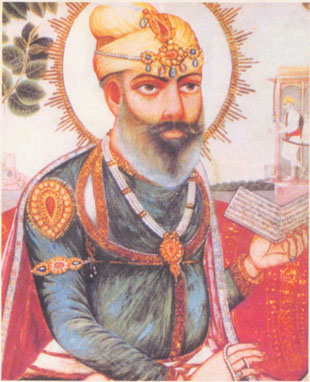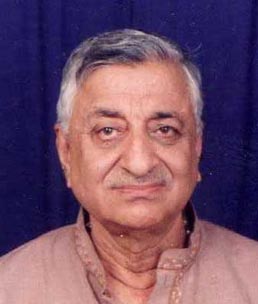Martyrdom of Guru Tegh
Bahadur and Kashmiri Pandits
The martyrdom of Guru Tegh Bahadur has a
multi-dimensional significance in the annals of
Kashmir, especially for the survival of Kashmiri
Pandits. Aurangzeb was very eager to convert India,
“the land of the infidels into the land of the
faithfuls”. The Brahmins preserved the Hindu
religion and their wholesale conversion to Islam
would have helped him in bringing the rest of the
Hindus into Muslim fold. He thought of converting
Brahmins to Islam because they form the core of the
Hindu religious tradition. So he started persecuting
them.

Guru Tegh Bahadur
Picture Courtesy: Koshur Samachar
Kashmiri Pandits were renowned for their learning
and orthodoxy. When the Mughal emperor turned his
eyes towards them, he encountered stiff resistance.
During 49 years of his reign, Kashmir was
administered by 14 governors. Iftikhar Khan was the
most fanatic and bigoted of these. He ruled Kashmir
from 1671 to 1675. He was using force ruthlessly to
convert Pandits to Islam. Faced with an ultimatum,
many of them began to flee Kashmir. Those who stayed
back and refused to accept Islam were put to sword.
Some Kashmiri Pandits met under the leadership of
Pandit Kripa Ram of Mattan and decided to go to the
Swami Amarnath cave temple and invoke the mercy of
Lord Shiva. At the holy cave temple, one of them saw
Lord Shiva in a dream Who told him to go to Tegh
Bahadur, the ninth Guru of Sikhs, and ask for help
to save the Hindu religion. He spoke to his
companions about the revelation and they all decided
to appeal him.
Guru Tegh Bahadur was a multi-faceted genius. He
was a Prophet, a Saviour, a Mystic, a poet, a martyr
and a great visionary. A visionary who could
understand reality in its totality. He was saviour
of the Hindus. He fought against fanaticism and
championed the cause of religious freedom. He was
one of the greatest liberator of mankind. His hymns
gave a clear idea of his vision of life and have
been a source of spiritual solace to millions of men
and women. Mystics have a vision of life and the
Guru was a mystic visionary as well as a
revolutionary. He was a fearless man and an
enlighted soul. He was a saint, a yogi, a soldier
and a prince. He dressed like a prince, took part in
hunting, participated in battles, but was basically
a saint. He was a true yogi who led the life of a
householder.He fought in self defence and when he
deemed it fit, he laid down his life in defence of
helpless Kashmiri Pandits.
Guru Tegh Bahadur was leading a secular movement
and was immensely popular. He attracted large crowds
wherever he went. Out of 11 years of his spiritual
reign, he spent almost 8 years in traveling through
Bengal, Bihar, Assam, Orissa, Uttar Pradesh and
Punjab. He visited almost all the places earlier
visited by Guru Nanak Dev Ji to propagate the
message of humanity. During his tour, he came across
and exchanged views with Brahmins, Vaishnav saints,
Sufis and all those who had been upset by
Aurangzeb’s increasing oppression. The Guru came
to be admired by them. He was all compassion for the
suffering humanity and people flocked to him in
large numbers. The Guru maintained an open kitchen.
To serve the congregation the residents of the
villages voluntarily collected food stuffs, milk and
butter for Guru’s langer. It was his
identification with the people and his love and
compassion for them, which created the popular
perception of the Guru as a hero who could come to
the rescue of the down- trodden. They took him as
their saviour. He became a source of spiritual
solace for the suffering people and they saw in him
their protector against tyranny. That is why the
Kashmiri Pandits felt that he could help them and
protect them from the tyrannical rule of Aurangzeb.
The Mughals ruled India for more than two hundred
years. Earlier Muslim dynasties had very short span
of life .The Khalji dynasty ruled for 30
years(1290-1321), the Tughlaq dynasty for 94
years(1321-1414), Sayyads for 37 years
(1414-1451) and the Lodis ruled for 75 years. The
Mughal emperor Aurangzeb wanted to convert India-the
land of ‘infidels’ into an Islamic country.He
considered conversion to Islam as a part of his
imperial policy.He demolished temples and humiliated
Hindus. He tried to make the Mughal state a Muslim
theocracy. In November 1665 he issued orders that
Holi not be celeberated and in the same year Diwali
was also banned. In 1668 Aurangzeb banned the
holding of Hindu festivals in pilgrimage centers. In
1668 he banned music and dismissed musicians. Taxes
were imposed on Hindus in almost every field.
Pilgrim tax was imposed in 1679. Jizya was
re-imposed in the same year. It was an attempt to
humiliate the Hindu elite. Abu Talib was sent to the
friendly state of Jaipur and he reported that he had
demolished 66 temples at Amber. During his march to
Deccan the emperor ordered the destruction of all
the temples en-route. He celebrated his victory over
Golkanda by destroying temples at Hyderabad. In 1692
he ordered that the temple at Rasulpur should be
destroyed. Hiteshwar Mandir at Barnagar in Guujarat
was destroyed in 1693. In 1696-97 temples at Sorath
in Gujarat were demolished. He stopped the public
worship of idols at Dwarka. Prominent Hindu temples
demolished on orders from Aurangzeb; Lalita Temple
at Delhi, Temples of Malirana(Jaipur),
Vishhvanath temple and Gopi Nath temple at
Benaras in August 1669. Vallabhcharya temple at
Mathura.At Surat the Brahmins were asked to pay a
large sum of protection money. In 1707 Hindus
were not allowed to burn their dead on the banks
of river Sabarmati at Ahmedabad. Fireworks of all
kinds were prohibited as per Fatwa-e- Alamgiri.
Almost the whole of the Muslim period in the history
of India was a crusade against Hindu religion and
culture.
In March 1671 a Muslim officer was sent to Ujjain
to demolish Hindu temples. The Hindus of Ujjain rose
in protest. They rioted and killed the officer and
many of his soldiers. There were many other stray
attempts by Hindus to resist the high handedness of
the emperor. It was Shivaji who was the lone
protector of Hinduism. He fought many battles and
finally founded Maratha Empire.
The Hindu centers of pilgrimage were citadels of
Hinduism. Aurangzeb focused his attention specially
on Kashmir, Kuruksheta, Varanasi and Haridwar. He
ordered that the Brahmins of these places should be
brought into the fold of Islam. According to
Macauliffe, ‘The Sikh Religion’ Vol. IV.
P369.” The experiment of wholesale conversion was
first tried in Kashmir. The Kashmiri Pandits were
well known for their scholarship and converting them
to Islam would encourage other Hindus to embrace
Islam. Surrounded as they were with Muslim lands,
they could be threatened with war and complete
annihilation. The peaceful Kashmiris could not be
expected to resist the Muslim military might. The
emperor also felt that he might succeed in tempting
the Brahmins from Kashmir into accepting Islam by
promises of money and government appointments.”
Koer Singh Kalal, the author of ‘Gurbilas Patshahi
Das’, Chapter IV. Says that “there was piled up
a heap of a maund and quarter of janeus (sacred
threads) of the Hindus who had embraced Islam under
the command of Iftikhar Khan. Many of the Brahmins
who did not accept Islam under the threat of death
managed to escape from Kashmir and under the
guidance of Kirpa Ram, they reached the Darbar of
Guru Tegh Bahadur.”
On May 25,1675, when 500 Brahmins from the valley
led by Pandit Kripa Ram (a sanskrit teacher in
Gobind Rai) came to Anandpur to narrate their story
of repression and woes to Guru Tegh Bahadur. The
Guru was moved by their entreaties and told them
that their problem could be solved only if some soul
of truthfulness and integrity offers himself for
sacrifice. His son, Gobind Singh, who was at that
time just nine years old, said; ”Who else can be
more truthful and sublime than you! You alone can
protect the Hindu religion. You alone are that
graceful and sublime.” Guru Tegh Bahadur was
delighted to hear the brave words of his son. He
told the Kashmiri Pandits to go and tell the emperor
that if he could be able to convert the Guru to
Islam, they would gladly follow him. This resolve of
the Guru and his ultimate sacrifice brought
tremendous change in the body politic of India,
leading in turn to the establishment of the Khalsa
by his brave son Guru Gobind Singh, the decline of
the Mughal supremacy and re-establishment of
religious tolerance.
Malcolm writes in ‘Sketch of Sikhs, P.33’
;” The Sikhs stung by a deep sense of injuries
listened to the Guru with all the ardour of men
commencing a military career of glory. They listened
with rapture to a son glowing, with vengeance
against the murderers of his father who taught a
doctrine suited to his troubled state of mind,
called upon his followers by every feeling of
manhood, to lay aside their peacable habits, to
graft the resolute courage of the solider on the
enthusiasm of the devotee to swear eternal war with
the cruel and haughty Mohammedans.”
On November 11, 1675, Guru Tegh Bahadur attained
martyrdom at Chandi Chowk, Delhi. It is known as
Gurdwara Sisgunj Sahib. Three of the Guru’s
devotees, Bhai Mati Das, Bhai Sati Das and Bhai
Dayala, had been tortured to death a day earlier on
the very spot on which the Guru was martyred. Before
these fearless followers of the Guru had their tryst
with divinity, the Guru had blessed them and
said,” All my blessings are with you --- my noble
disciples. What greater joy and pride can I have
than the thoughts that my dearest disciples were
with me. “
Guru Tegh Bahadur’s martyrdom is an event of
greatest importance in the evolution of the Indian
ethos, especially the history of Kashmiri Pandits.
In his supreme sacrifice can be perceived the
triumph of the eternal glory of the Indian spiritual
tradition.
| 














No one has commented yet. Be the first!